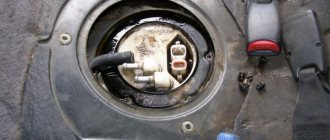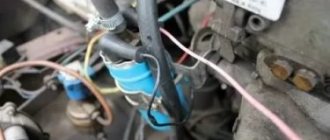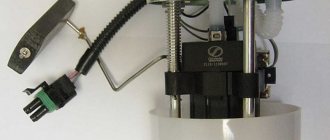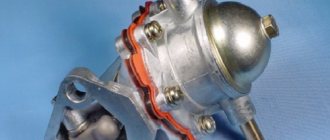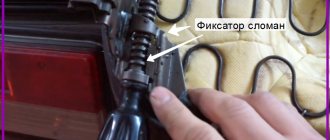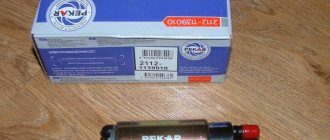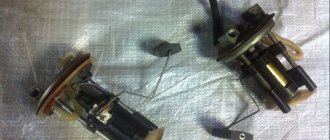Maybe I'm exaggerating, but it seems to me that every classic encountered such a problem. In the heat, when the car was moving (in my case it was a VAZ 2106), the car began to twitch or completely stall in the most inconvenient places (crossroads, on the highway, etc.). If you open the hood and look at the fuel filter at this time, you could notice that it is empty or there is very little gasoline there; when you try to manually pump gasoline from the fuel pump, you can understand that the fuel pump does not pump gasoline. Everyone solves this problem in their own way, I let the engines cool by 10-15 degrees, then moistened a rag, threw it on the gas pump, successfully started the engine and drove home. (I want to make a reservation right away, I always had a new fuel pump repair kit in the car, I have a DAAZ fuel pump. Pekar g * but there were two of them, the same problems with them.) In general, I removed the fuel pump, took it home, disassembled it, to my To my surprise, everything was fine with it, the diaphragms were not torn, the valves were normal, but since I had a repair kit, I replaced everything with a new one and installed it on the car. The problem has not gone away. Air jams still formed. Then I went to an auto store, bought a fuel pump pusher, it was 8.25 cm long, took off the old one, measured it, its length was 8.2, the difference in principle is not big, I installed a new pusher, drove it, and still the problem did not disappear. I no longer knew what the reason could be, I also went to the auto store, bought a rod with a pusher, removing the old rod with a pusher, I noticed that the rod was cracked, + in addition to all this, there is a 1mm thick gasket between the block and the rod, not order! There should be a gasket with a thickness of 0.27-0.3 mm... Next, installing a new rod + a new pusher that came with the rod, I adjusted the protrusion of the pusher to 1.1 mm (0.8-1.3 seems to be allowed). I installed a new fuel pump (because I had ruined the old one) and that was it, my problems disappeared. I still think that the problem was in the rod and an incorrectly installed gasket, but what’s most interesting is that we drove like this for almost 3 years, with an incorrectly installed gasket. But at the same time, every summer I had to buy a new fuel pump, because this only solved the problem of an air lock...
That's all, if someone solved this problem differently, please leave a comment, I will be very grateful to you
When operating the “seven”, one of the problematic components is the fuel pump. Sometimes its malfunctions have to be fixed urgently, “on the road”. Therefore, it will be useful for every owner of the “Seven” to know how the VAZ 2107 fuel pump (carburetor) works, what its main malfunctions are and how to repair it.
What fuel pumps were equipped with classic VAZ models?
Classic VAZs include all models of the Zhiguli family, produced from 1970 to 2012 and their modifications:
Depending on the year of manufacture, the engines of these vehicles were equipped with different fuel systems. In all the first Zhiguli models, the fuel mixture was injected into the cylinders using a carburetor, and the fuel was supplied by a mechanical fuel pump. The latest modifications of the VAZ 2104, 2105 and 2107 had an injection system and an electric fuel pump.
Carburetor cars of the Zhiguli family were equipped from the factory with mechanical fuel pumps of the diaphragm type DAAZ 2101 (catalog number 1106010) produced by the Dimitrovgrad Automotive Unit Plant. Thanks to their simple design, reliability and maintainability, they have proven themselves well not only on the “classics”, but also on cars of the Sputnik and Samara families, which were equipped with their modified versions.
Carburetor VAZ 2101–2107 were equipped with DAAZ mechanical fuel pumps
Injection Zhiguli models were equipped with domestically produced electric fuel pumps. They were produced by the Pekar and Utes enterprises under catalog number 21073–1139009. The latest modifications of the Zhiguli were equipped with products (catalog number 2112–1139009). The same devices were installed on all models of the Samara and Lada families.
Injection models of classic VAZs were equipped with electric fuel pumps “Pekar”, “Utes”, “Bosch”
Causes of misfire in injection engines
Since carburetors have a lot of shortcomings and unstable operation, injectors are mainly installed on modern cars. Stable operation, efficiency, frost resistance and environmental friendliness ensure the reliability of the motors and their durability. Injection engines are equipped with an ECU that regulates the composition of the combustible mixture and its supply.
When problems arise with fuel ignition, an error appears in the control unit, which helps to identify the faulty part of the unit.
When a breakdown is detected, it is necessary to conduct in-depth diagnostics to identify all faults. The most common reasons are the following.
Combustible mixture quality
If the air-fuel mixture has incorrect proportions, it will not ignite. Sometimes simply changing the gas station is enough, but in some cases major repairs may be needed. Low-quality fuel can clog injectors and filters. The reason for supplying the mixture in the wrong proportions may be a faulty fuel pump or pressure regulator. It is better to entrust complex diagnostics to authorized service stations, since independent examination of devices does not always allow you to detect an error.
Candles
Worn spark plugs can lead to misfires at idle and the engine constantly stalling. Sometimes you come across defective spark plugs that do not produce a spark. A change in the gap can also cause the fuel-air mixture to fail to ignite.
Armored wires
Faulty high-voltage wires do not cope with the task, which leads to misfires. Damage due to the mechanical impact of the armored wires or high resistance in them does not allow the mixture to ignite and can cause engine failure.
Cylinder deformation
If the gap between the piston and cylinder has changed, then significant changes appear in the operation of the engine. Although this reason is quite rare, it must be taken into account during a full diagnosis.
Incorrect compression
Uneven or low compression of the combustible mixture prevents it from igniting. The problem arises due to a violation of the integrity of the piston rings or wear of the CPG.
Malfunctions of the device can cause misfires on a cold engine. Due to the incorrect size of the device gaps or leaks in the hydraulic compensators, problems may arise when the mixture ignites.
There are many reasons for the omission, so it is necessary to carefully carry out a comprehensive diagnosis. Situations often occur in which several faults are considered (electronics and condition of the cylinders, fuel quality and condition of the timing belt, valve and spark plug).
Where is the fuel pump located on 2106, 2107 and other models
The location of the fuel pump on carburetor and injection classic VAZs is different. In the first, it is installed on the left (as viewed from the passenger compartment) on the engine cylinder block on a special boss, and is attached to it using studs through a heat-dissipating ebonite spacer. The mechanical fuel pump is driven from the engine intermediate shaft through an eccentric and a pusher (rod).
The mechanical fuel pump on the classic is mounted on a special boss on the engine cylinder block
In injection Zhiguli cars, the pump is included in the design of the fuel module. It is located inside the gas tank. The design of an electric pump consists of a DC electric motor and a specially shaped impeller mounted on its shaft. The electric motor is powered from the vehicle's on-board network. The electrical circuit of the device is protected by a separate fuse and relay.
The electric fuel pump on injection classic models is installed in the gas tank
Checking, repairing and replacing a mechanical fuel pump
Methods for diagnosing fuel pumps for carburetor and injection engines of Zhiguli are also different. Checking a mechanical pump consists of determining its performance, as well as assessing the condition and performance of its component elements.
How to check the performance of a mechanical fuel pump
The productivity of the DAAZ mechanical pump is 1 liter per minute. To check the amount of pumped fuel you will need:
Remove the fuel hose from the outlet fitting
We estimate the amount of fuel pumped by the pump per minute
If the amount of gasoline is less than 1 liter, the fuel pump is faulty.
Assessment of the condition and performance of component parts
The following pump elements must be checked:
Design of the DAAZ fuel pump
Checking the valves consists of determining the air pressure at the outlet fitting and the vacuum at the intake
The mesh filter should not show signs of damage or deformation
If the pump diaphragms are damaged or deformed, they must be replaced.
Removing the pump thermal spacer
The length of the pusher should be 82.5 mm
Do-it-yourself repair of a mechanical fuel pump
It is not advisable to purchase faulty fuel pump parts separately. It is much more profitable to purchase a repair kit, which includes elements that may fail, namely:
Fuel pump repair kit
Repairing a fuel pump involves dismantling and disassembling it. They are produced according to the same algorithm that was described earlier in the diagnostics section. If, after disassembling the fuel pump body, you find that there is dirty deposits or debris on its walls or on the inner surfaces of the fittings, clean them with carburetor cleaning fluid and a piece of coarse cloth. When removing plaque, use a small wooden spatula and toothpicks. It is highly undesirable to use metal objects for these purposes.
Removal
1. Relieve the pressure in the power system (see “Relieving pressure in the power system”).
2. Disconnect the wire from the negative terminal of the battery (see “Battery - removal and installation”).
4. 7 mm
Unscrew the eight nuts securing the electric fuel pump to the fuel tank around the perimeter of the flange.
5. Lift the electric fuel pump and tilt it, removing the float of the fuel level indicator sensor from the hole.
6. To remove the receiving mesh filter, carefully pry it off with a screwdriver.
7. Remove the filter from the pump tip.
8. Wash the filter in acetone or a similar solvent, clean it with a hard brush and blow it with compressed air.
9. To replace the fuel level indicator sensor, use a screwdriver to release the clamp of the sensor and pump wire block. Disconnect the block.
10. Using a slotted screwdriver, press the wire clamp and remove it.
11. Mark the position of the wires in the block so as not to confuse them during assembly. Use an awl to press out the ends of the sensor wires and disconnect them from the block.
12. Using a slotted screwdriver, unscrew the screw securing the ground wire of the pump and the lower mounting of the sensor.
13. Using the same tool, unscrew the screw of the upper sensor mounting.
14. Remove the fuel level indicator sensor.
Diagnostics and replacement of the electric fuel pump on cars of the Zhiguli family
In injection engines of classic VAZs, the fuel pump may lose its functionality both due to problems with the power supply to it and due to a malfunction of its electric motor. In the first case, the situation can be corrected by diagnosing and repairing the electrical circuit of the device. But if the electric motor of the pump fails, only replacing it will help.
Checking the protection devices for the electrical circuit of the fuel pump on injection VAZs of the Zhiguli family
If there is a problem with the electrical equipment of the fuel pump circuit, it usually does not turn on at all. Turn on the car's ignition without starting the engine and listen. First, you should hear a click from the relay, and then a characteristic “squeal” emitted by the pump’s electric motor. If you don’t hear anything like this, start diagnosing with the electrical circuit of the device.
The pump circuit is connected to the on-board network via a separate relay, and its protection is provided by a fuse. Both of these devices are located in the vehicle's optional mounting block. You will find it under the glove box. It contains 3 relays and 3 fuses. The fuel pump relay (indicated R2 in the diagram) is located in the middle, and the fuse (F3) is to the left of it. We pull the fuse out of its seat and check it by “ringing” it with a tester. If a malfunction is detected, we replace it, not forgetting to comply with the rating (15 A).
You can check the functionality of the relay by installing a known working device in its place. Instead, replace it with the relay located to the right of the one being diagnosed, which is responsible for the radiator fan circuit. If this option does not suit you, turn on the ignition and measure the voltage between the pink wire going to the relay and the vehicle ground. The device should show 12 V. This means that the device is powered. After this, you need to connect the pink wire with the gray one at the relay terminals. So we will connect the fuel pump directly to the battery. If it works (that same “squealing” sound will be heard), simply replace the relay.
The fuel pump relay is located in the middle (R2), and the fuse is located to the left of it (F3)
Checking the fuel pressure in the system
The main indicator of the operation of a fuel pump is the pressure it creates in the system. If the device turns on, pumps fuel, but the engine runs intermittently, take the time to check the pressure. To do this, you will need a pressure gauge with a measuring range of 5–7, equipped with a gas-resistant hose and a threaded fitting (if there is no special one, you can use a regular tire pressure gauge). The sequence of actions is as follows:
Main causes of malfunction
The fuel pump can stop functioning only for two main reasons - lack of fuel in the beam or the occurrence of malfunctions.
In the second case, the causes of breakdowns are usually as follows:
- Using poor fuel that does not meet quality standards.
- Valve failure. Most often, they simply become clogged, in which case it will be enough to dismantle the lid and mesh of the device and then clean them. If the valves are loose and their position is unreliable, the pump will need to be completely replaced.
- A blockage in the filtration system through which the fuel passes, causing excessive pressure to be applied to the pump, preventing it from functioning properly.
- Lack of timely refueling and driving a car with a minimum amount of fuel in the tank. This causes the device to idle, which quickly leads to its malfunction.
- Relay or fuse failure.
The VAZ 2107 is equipped with an injection pump - this is a fairly reliable device that rarely fails.
In most cases, all breakdowns occur due to the driver’s fault; If you suspect a malfunction, you can check the fuel pump in the following way:
- Using a screwdriver or a special wrench, loosen the clamp of the incoming hose through which the fuel is supplied, after which it can be removed from the studs.
- Install a plug using a bolt with a diameter of 8 mm; it will prevent fuel from leaking out.
- Make several movements using the hand drive lever. At this moment, it is necessary to monitor the outlet fitting - a sufficiently strong stream of fuel should shoot out of it, which will indicate that the device is in good condition. If this does not happen, you will need to move to the next step to continue the diagnostic process.
- It is necessary to loosen the clamp of the outlet hose and install a plug in the same way as was done before.
- A damper is placed on the inlet fitting; you can simply hold it with your finger, and then operate the manual drive lever again. The absence of a feeling of vacuum and suction of the finger inside will indicate that a breakdown has been detected: the fuel pump should be replaced or repaired.
- If no faults are detected at the previous stages, it is necessary to check the fuel line; most likely, it will be the cause of the breakdown.
Unlike older models, the VAZ 2107 was equipped with an electric fuel pump, so its transition to operating mode and the start of operation is indicated by a characteristic buzzing sound that occurs after turning the winding key. Its absence may indicate a failure of the relay and fuse, so these parts of the device should be checked first.
It's quite easy to do this:
- You need to find a bracket with fasteners for these elements; it is located under the front panel near the glove box. It should have 3 relays and 3 fuses installed.
- Initially, the outermost fuse on the left side is inspected; there should be no signs of burnout on it.
- Next, the relay located in the middle is checked - you will need to check the voltage readings between the body negative after turning on the ignition and the pink wire.
- If there is a voltage of 12V, you need to short the pink wire to the gray wire, which will allow you to connect contacts 30 and 87 of the relay. The start of operation of the fuel pump will indicate a failure of the relay. This can be checked by temporarily installing a working relay removed from another vehicle.
Fuel pump VAZ 2107 injector
The injection “seven” has a number of fundamental differences from the carburetor version of the car. This difference relates primarily to the fuel supply system. In the design of the VAZ 2107, the injector does not have a carburetor, and the gas pump pumps fuel directly to the injectors: this is reminiscent of the supply system of diesel engines.
Purpose and device
An electric fuel pump, unlike a mechanical one, is responsible not only for delivering fuel from the tank to the combustion chamber, but also for creating high pressure in the fuel system. Fuel injection in injection systems is carried out using nozzles, and gasoline must be supplied to them under high pressure. Only an electric pump can cope with this task; a mechanical one is not suitable here.
The VAZ 2107 fuel pump injector is designed quite simply and thanks to this it has a long service life. Essentially, it is an electric motor with blades located on the front of the shaft, which pump gasoline into the system. The pump inlet pipe is equipped with a coarse fuel filter in the form of a mesh to retain large dirt particles. The design of the electric pump is complemented by a fuel level sensor, which transmits a signal to the instrument panel.
Operating principle
To better understand the principle of operation of the gas pump, you need to have an idea of the injection system as a whole. Such a system consists of:
The VAZ 2107 fuel pump injector starts working after the driver turns the ignition key. At this moment, the electric motor of the pump turns on, and the pressure in the system begins to rise. When the fuel system pressure reaches 2.8–3.2 bar (280–320 kPa), the engine starts. While the engine is running, the gas pump pumps fuel into the system, and the pressure is maintained at the required level. After the engine is turned off, the pressure drops within a few minutes.
Where is
The fuel pump of the VAZ 2107 car, the injector is located inside the fuel tank. If you open the trunk lid, the tank with the pump can be seen on the right. The advantage of this arrangement is the simplification of the fuel system, the disadvantage is difficult access to the fuel pump.
Which fuel pump is better
If we compare an electric and mechanical fuel pump, it should be said that:
The basis of malfunctions of VAZ carburetors
The first signs of a carburetor malfunction may be the engine turning off immediately after starting or unstable operation at idle speed. The causes of these problems are:
- Clogged fuel nozzle channels XX. To fix this problem, you need to remove the nozzle, disassemble it and blow out the channel from the end with compressed air.
- Malfunction of the EPHH control system or electromagnetic jet (malfunction of the VAZ-2107 carburetor). In this case, you should check the power supply to the valve from the control unit using a test lamp. The performance of the valve itself can be checked using a tester.
- Violation of the tightness of the float mechanism. In this case, the specified fuel level in the chamber is not maintained. As a rule, gasoline overflow occurs. To eliminate the malfunction, you must first replace the needle along with the seat, and then adjust the required fuel level.
- Insufficient clearance at breaker contacts. A sign of this may be unstable speed due to strong sparking of the contacts or a poor-quality spark. To eliminate the malfunction, it is necessary to adjust the contact gap (0.4 mm) and check that there is no play in the bearing.
- Failure of the resistor, which is built into the distributor runner, can lead to poor spark quality. In this case, you will have to replace the resistor. If a breakdown occurs on the way and you need to continue moving, you can temporarily repair the broken circuit with a thin wire, wrapping it around a resistor.
- Wear or large play of bearing 800706U in a distributor with a vacuum corrector can be determined by an unstable spark. The damage can be eliminated by replacing the bearing.
- Air leaks into the intake pipe can be the result of the following problems:
violation of the tightness of the hose or the vacuum brake booster system itself;
- burnout of the head gasket or failure of the pipe connection;
- wear or deformation of the crankcase ventilation system spool, which is located on the axis of the first chamber;
- failure of the drainage tube;
- coking of the annular slot zone of the quantity screw and sprayer.
The car accelerates poorly or with dips
If the engine speed in idling mode is stable, but the car has dips or picks up speed rather slowly, malfunctions of the VAZ-2109 carburetor can be caused by the following problems:
- the fuel level in the float chamber is low;
- insufficient fuel injection due to improper operation of the accelerator pump;
- late ignition;
- sticking of the centrifugal regulator of the ignition system interrupter-distributor;
- the dimensions of the nozzles or air and main fuel jets do not correspond to the specified parameters;
- clogging of the channels of the quality and quantity jets;
- plaque on the emulsion tube of the primary chamber due to water ingress;
- suction in the intake manifold or mismatch of the XX jet, which is typical after installation of a gas installation;
- malfunction of the coil, slider, resistor, spark plugs or broken wire.
Signs of a fuel pump malfunction
A faulty fuel pump can be determined by the following symptoms:
The fuel pump does not pump
If, after turning the ignition key of the injection “seven”, you do not hear the usual sound of the fuel pump running, you need to check the electrical power circuit, as well as the mechanical part of this unit.
Checking the relay and fuse
Troubleshooting begins with the relay and fuse box located in the cabin under the glove compartment. To make it more convenient to work, the block must be removed from the niche by pulling it towards you. The fuel pump fuse is located in the middle of the block (indicated by the number 4 in the figure), the fuel pump relay is located slightly to the right of the fuse (in the figure - 5).
From the connection diagram it can be seen that voltage is supplied to the fuel pump through the fuse and relay. Therefore, first of all, you need to check the integrity of the fuse: this can be done, for example, with a multimeter. If the fuse turns out to be blown, and after replacing it the car runs fine, then you have the easiest emergency of all. If the fuse is intact, then further actions are as follows:
Electric fuel pump device
injection pump
ordinary and conditionally can be divided into two parts:
The most important thing is its structure itself. The fuel pump in the VAZ 2107 is a replacement. The fuel pump fuse (injector) is also clogged. Testing and replacement of the VAZ injector fuel pump, replacement of the VAZ 2110 fuel pump. The electric fuel pump itself is hermetically sealed to protect against the ingress of fuel. The fuel enters the pump through the filter and the intake hole and is supplied to the power system through the outlet hole (sealed from the electric motor).
Here is such a scheme you can find. I would like to point out that it does not happen that the rotor of the engine spins in water and, moreover, in gasoline. Return to contents Description of work. The location of the VAZ 2110 injector fuel pump is in the gas tank located under the bottom of the car, in the area of the rear seat. Firstly, a spark appears on the collector when the engine is running. You yourself realize that this will lead to a fire. Replacing a VAZ 2107 fuel pump: photos and videos. Checking and replacing the VAZ 2110 fuel pump can lead to overheating of the VAZ-2110 injector fuel pump. Secondly, rotation of the rotor in water is so difficult that gaining speed and developing pressure is simply out of the question.
Fuel pump drive
The VAZ 2107 mechanical fuel pump is driven by a pusher and an eccentric. Among drivers, it is customary to call the pusher a rod, although the rod is another part of the fuel pump. The eccentric is located on the intermediate shaft, which operates from the gas distribution mechanism.
The fuel pump drive includes (see figure):
Device and principle of operation
The operation of the mechanical fuel pump drive is not based on the fact that:
Drive faults
Problems with the mechanical fuel pump drive lead to interruptions in the operation of the fuel supply system. Actuator malfunctions are most often associated with deformation or excessive wear of the pushrod or cam.
Fuel pump rod bends
The fuel pump pusher is often made of metal that is not strong enough. There are often cases when, after 2–3 thousand kilometers, such a pusher bends and flattens the constant impact of the cam. The length of the pusher should be 82.5 mm. If your fuel pump tappet does not meet this size and is flattened on the cam side, it will need to be replaced.
What is a fuel pump and why is it needed?
So, the first thing I want to talk about is what a fuel pump is and what it is intended for. As you can already understand from the name, the gas pump comes from two words: gasoline and pump, that is, it is a pump that pumps gasoline, everything seems to be clear here, and there is nothing complicated about it. In the fuel system, the fuel pump - if compared with the human body, can be called a heart, since our heart is also a kind of pump or pump that pumps blood, providing the body with everything vital. Life is impossible without a heart (fuel pump), and this also applies to a car with a non-working gas pump. The car turns into a static pile of metal that is incapable of anything.
Fuel pump repair
To dismantle the electric fuel pump you will need:
Removing the electric fuel pump
Dismantling the electric fuel pump is performed in the following sequence:
If you need to replace or wash the coarse filter, you need to pry it off with a screwdriver and remove the old mesh. The new filter is installed by pressing tightly.
The fuel pump is installed in reverse order.
Checking the ignition coil
The coil is checked based on two indicators: the presence of a short circuit and an open circuit. Before diagnostics, the ignition coil must be disconnected. After this, one probe of the device is connected to the central contact of the coil, the second to the body (ground). If the display shows resistance equal to infinity, there is no short circuit.
The primary winding of the coil for a break occurs differently. The probes of the device must be connected to the right and left contacts. The resistance between them should be within 3-3.5 Ohms.
If the resistance of the primary winding does not correspond to the norm or there is a short circuit in the coil to the housing, it must be replaced.



